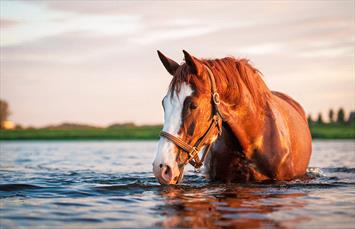The hottest part of the summer certainly affects our animals, and this includes horses. The most important thing for horses during extreme heat is fresh, clean water. An average adult horse needs five to seven gallons per day in cool weather, but in hot weather, depending on activity, may need 20 gallons. With multiple horses, you need several water tanks spaced apart so one dominant horse can not keep timid horses from drinking. Adding electrolytes to the feed is a really good idea all year round, but especially important at this time to keep them drinking and to replace electrolytes lost in sweat. A salt block is okay, but horses need extra electrolytes also.
HorseWading

Horses need lots of water to stay safe in the heat.
For horses that do not drink well, Dr. Nancy Loving indicates in the Horse magazine that adding water to the feed will help increase intake, especially if you are traveling and the water tastes differently. Hot weather also brings flies, so don’t forget fly sheets, insect repellant, and fans to keep the insects off at certain times of the day. Lots of horses are allergic to flying insect bites, so bringing them in at dusk and dawn under fans may help decrease the problem. Hopefully, you have some shade trees or a loafing shed in the pasture with good ventilation.
Although concerning, this is really not a problem with horses that are not being worked and are just resting in the pasture. Heat stress is a concern for horses working hard in this hot and humid weather, especially if you have a horse that is not sweating (called anhidrosis).
If you think your horse is developing heat stress with an increased respiratory rate even at rest, check the temperature, and if it is over 103.5°F, remove the tack, spray the horse with cool water, and then scrape it off until the temperature is less than 102°F and breathing is regular.